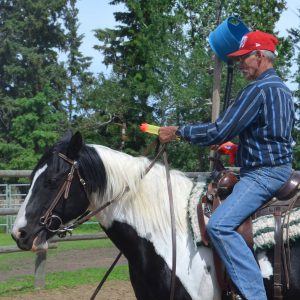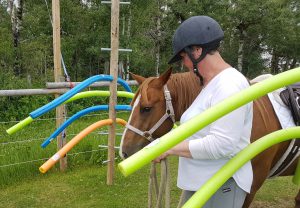I’d like to introduce five of our Strategies for Success that we follow when we start working with horses on obstacles or anything new and unknown.
- We build it in the groundwork, then ride it in the saddle.
- We never force a horse to go on, over or though something they’re scared of. We do go forward when the horse is in release and following our focus.
- Find ground zero. This is the position, proximity to an obstacle, or a maneuver that we know the horse can achieve. We can always start successfully from our ground zero point.
- We define success as, “anytime the horse tries for us,” and reward and encourage our horse when he tries.
- We allow the horse the time he needs to investigate the obstacle before we continue to ask him forward.
In this article, we’re going to focus on #5. You’ll need to read Part 1, Part 2, Part 3 and Part 4 first.
 Our fifth and final point is a great learning opportunity not only for your horse, but for you. You’ll see a the process a horse must go through when he’s investigating whether something is safe or not.
Our fifth and final point is a great learning opportunity not only for your horse, but for you. You’ll see a the process a horse must go through when he’s investigating whether something is safe or not.
Fear and Curiosity – What are they?
I believe that fear and curiosity are almost identical. There are many articles you’ll find which discuss them as opposites. But they’re really not that different. The reason is that both fear and curiosity have an overwhelming factor in common – focus.
Here’s an example:
Bill is a gelding that has some trail time, but has always been scared of big rocks. Whenever he walks by one on the trail, all of his focus goes to the rock and he’s scared to let it out of his sight. His rider is nervous about going out on the trail because she knows he’ll spook at rocks. This is fear. All of Bill’s attention is on the rock.
Jill is a mare that is new to the trail. She’s young and bright. When she sees her first big rock, she stops and looks at it. Her owner notices her interest and allows her to walk over and check it out. She spends a few minutes sniffing and looking at it. This is curiosity. All of Jill’s attention is on the rock.
The difference in thinking from the perspective of the horse would be:
Fear: “That might kill me so I’m outta here!”
Curiosity: “That might kill me…but…it’s not killing me right now...hmmm…”

Consider that fear, from a prey animal’s point of view, is an instinctual response to anything
they consider life-threatening, and anything unknown IS life threatening until proven otherwise. Curiosity is an interest in something unknown. However, both share the commonality of focus or attention.
Turning fear to curiosity isn’t that hard. It requires two ingredients: time, and you.
Time. Given time, a horse will realize that something they’re nervous about is not going to kill them. This is closely tied to the distance to the object. If you’re working at leading or riding your horse up to something he’s scared of, when you recognize his fear, let him stop. Now wait. The horse will, in short order, realize that at that distance, they’re not going to die. When that happens, they’ll release tension and their focus may go elsewhere. That’s the moment you can ask for forward again. We covered this strategy in part 4.
You. When the horse is confident in your leadership, he’ll be looking to you for an answer to whether or not this scary thing is safe. Horses communicate in several ways, the important one here is empathic communication. That is, they are aware of how other horses feel. This could be fear, calm, energetically forward, or just about anything else. It’s a survival mechanism – they can communicate “safe” or “run now!” throughout the herd almost instantaneously. The important part here is this: how you feel about the scary thing is what your horse should be looking for, or picking up on. To make this successful, you must project confidence and release any tension you have in your body.
Because this type of communication is so intrinsic to the horse, I like to capitalize on it by taking it one further step: thinking that the object is the best place for our herd to be; the closer we get, the better it feels. Now I have to reiterate – you can use this only if your horse is confident in your leadership. If your horse does not trust in you OR he thinks you are below him in the herd order, he’ll not believe what you’re “saying”. Remember that trust is earned or built. Your horse (or people, for that matter) will trust you somewhere between 0% and 100% depending on past experience. Your job as a leader is to get that percentage higher. We’ll explore this concept in a future article.
Inspiring Curiosity – Eliminating Fear
That fear and curiosity are so closely related is a distinct advantage to us as leaders and a valuable tool in our horsemanship toolkit. It’s really not that hard to flip the switch from fear to curiosity. And when you do…mission accomplished.
When your horse moves forward, he’s demonstrating that he’s overcoming fear. When curiosity takes over – and it will – you’ll see your horse go through a sequential list of steps:
- Sniff it
- Muzzle it
- Bite it and/or paw it
- Look away because it’s boring
When a horse does this in my obstacle course clinics, I encourage it. It’s a clear demonstration that they’re engaging with something unknown, versus avoiding it. This is the horse’s way of making sure that an item is safe. It’s not bad, nor is it rude, for a horse to bite or paw something they’re unsure of. In fact, it is critically essential that you let them go through this process.
Let him take all the time he needs to do this. It might be 10 seconds, it might be 10 minutes. It’s time well spent. We need to make sure that the horse does not have any lingering thoughts of fear. If he does, and we add more pressure – for example asking a trot instead of a walk – you’ll see those lingering fears reappear, because we didn’t take the time to clean them up in the first place.
When you see their attention drawn to something scary or unknown, encourage them but do not force them closer. Sometimes its better that you just let them do what they have to do. When they’ve satisfied themselves, they’ll look up and left or right. We’ve discussed in previous articles that a horse has a singular focus. What that means is that their focus will be on the highest pressure (or most engaging thing) in their environment at any given moment.
Question: So when they look away, what does that tell you?
Answer: That something else is more important than the item they just sniffed or pawed.
That is a great, because it tells you that the horse is comfortable with the object in his current position.
I put the final words of the last sentence in italics for a good reason. Once you’ve introduce a horse to something and he has gone through the investigative steps – and then turned away, it’s now time to ask him to follow your focus forward again. Look ahead and ask your horse to move forward with you.

Now something interesting may happen. Your horse might stop, and go through all those steps again. Remember at the beginning of this article I mentioned that distance was an important factor. Just because a horse can be comfortable at 4′ away from an obstacle, does not in any way mean he’ll be comfortable at 3′.
There is one time when we might deviate a little bit. This is the case for the horse that will not look at the obstacle or scary path. The most interesting I’ve seen was a mare at a clinic of mine in 2018. When faced with something uncertain, she’d turn her head right around to her hip. She had a difficult time facing anything scary. In this case, instead of focusing beyond the obstacle, we focus on the obstacle. By doing this, we’re asking the horse to look at the object they think is too scary to look at it. Simultaneously, we are communicating that this thing is not really scary at all. At that point, they’ll likely investigate it.
In most other cases, however, you’ll see I’m always on your case to focus forward because that gives a horse a focus to follow. He has to be thinking beyond the obstacle to go over it. Focusing at it will cause him to stop.
And thus, this is a repetitive exercise. At this point I’ll sum up the entire article series:
- Start the exercise in the groundwork.
- Ask the horse to follow your focus forward.
- If he stalls or stops due to fear or uncertainty, you stop with him. This is your ground zero point.
- Ask your horse to release. When he does, go back to step 2.
- Now that you’re near the scary item, you’ll see your horse go through the investigative steps.
- When he looks up and away, go back to step 2.
- Remember to praise and encourage your horse every time he moves forward with you.
- Now you’ll be at or over the obstacle. Success!
By using this article series, you’ll be able to calmly introduce your horse to anything new and uncertain. By remaining focused, positive and encouraging, you’ll be building trust in your leadership with your horse. And by doing that, your horse will be more apt to follow you in the future, because you’ve proven yourself.
December 2018
Scott Phillips
